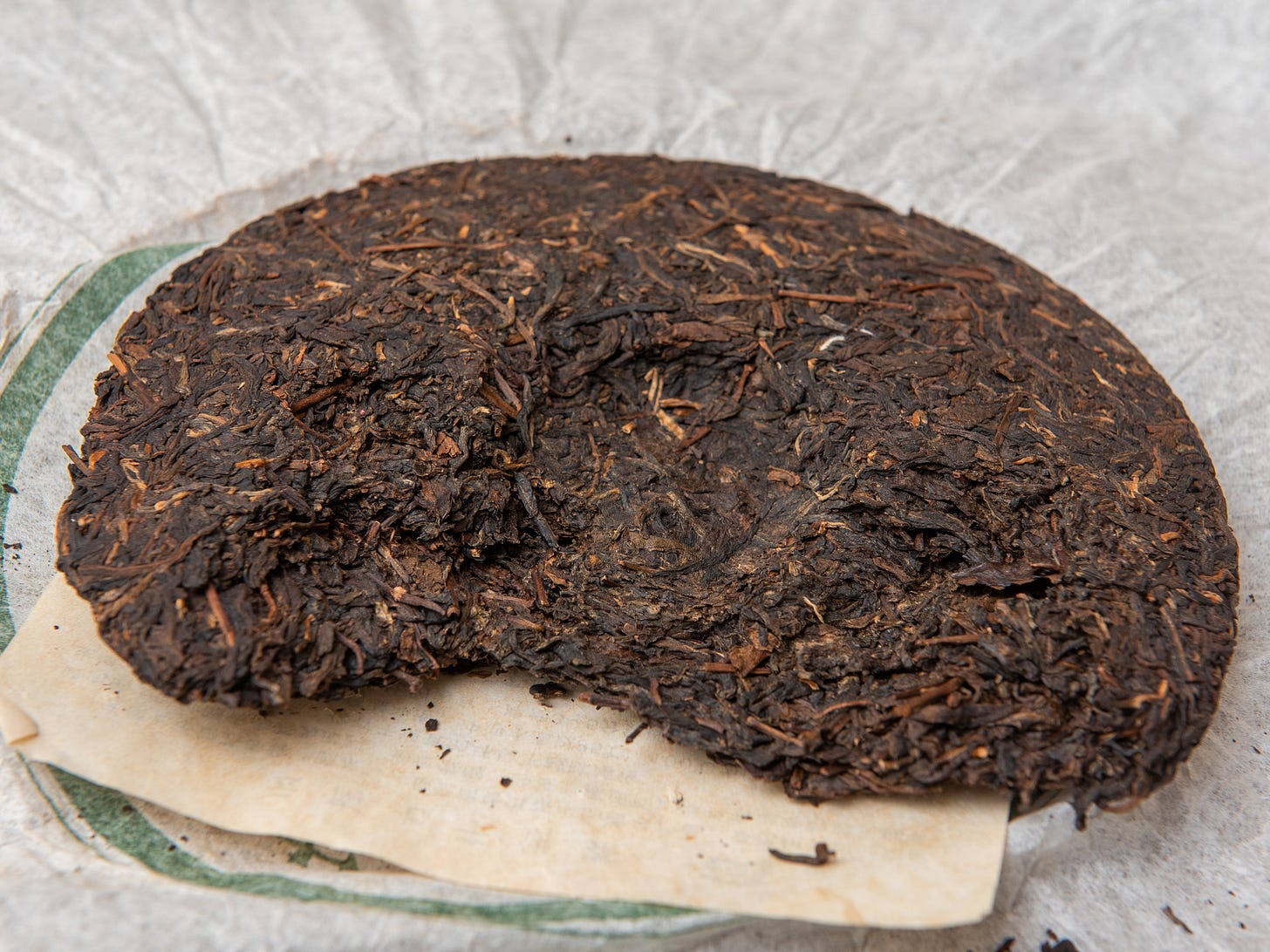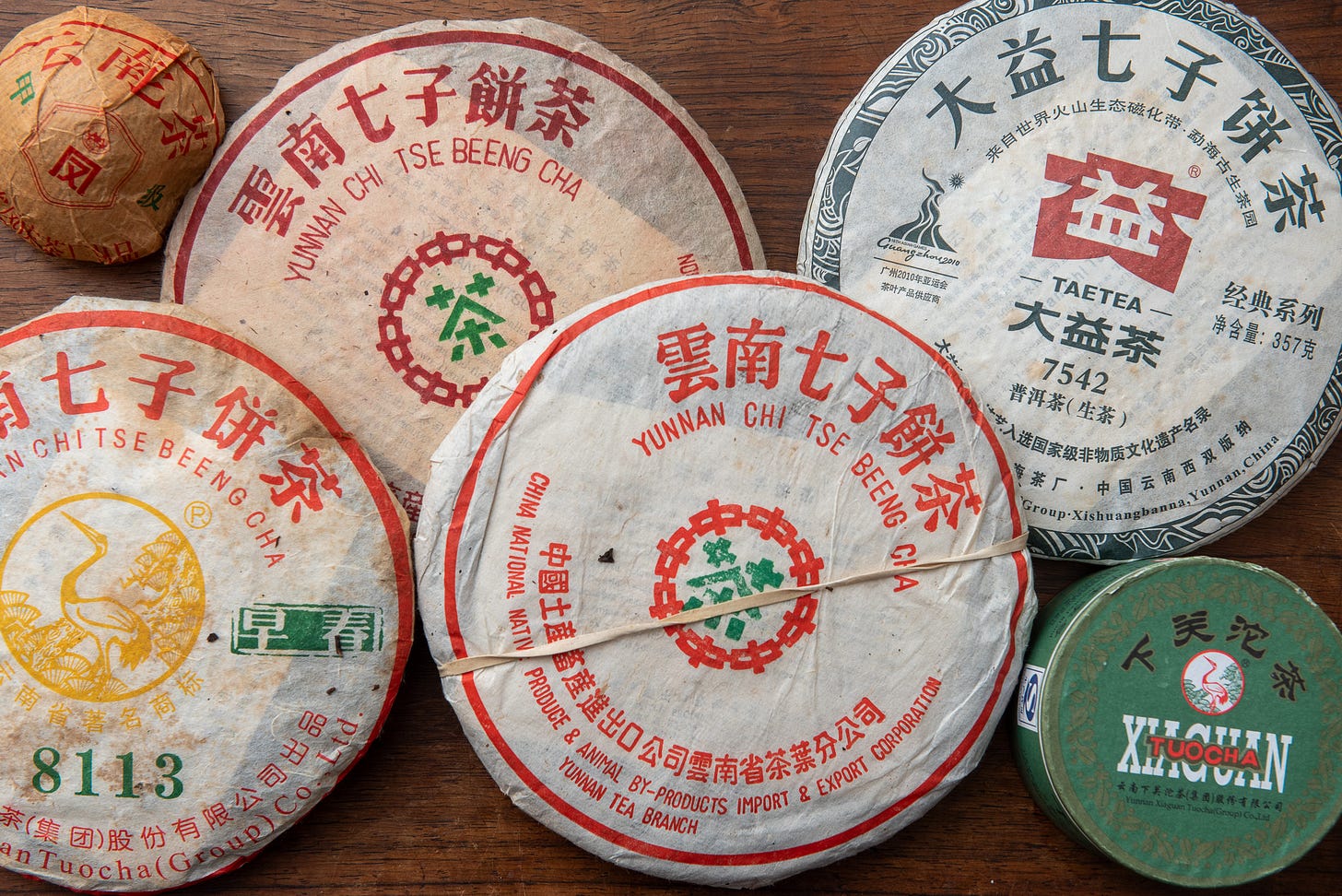Leafhopper’s spring sale
Tea harvest season is here, so this month you can save 20% on a monthly or yearly subscription to Leafhopper. This project is a labor of love but wouldn’t be possible without the financial support of Readers Like You. Paid subscribers get exclusive access to deep dives full of tea lore, controversies, and advice that’s hard to find on the web. That’s where I spend the bulk of my time writing this newsletter each week, so if you’re ready to explore the tea world further, now’s a great time to start!
Turn up the bass
The tea: 2008 Dayi 8582 raw puer, sold by Teas We Like. $110 for 357g.
There’s no such thing as bad weather, just weather more suitable for tea, and aged puer is what I want to drink during a week of rain on the forecast. The last time I covered an 8582 puer it was an unofficial “dupe” of the brand Dayi’s classic formula. This 17-year-old cake is the genuine article. The number 801 on the label designates that it was the first 8582 batch of the year (batch 01 of 2008) featuring the best quality spring leaves. It’s spent most of the time between production and now in Taiwan, affording it a different aged profile from the darker, more syrupy dupe stored in Hong Kong.
That’s all well and good about the wrapper, but how does the tea show up in the cup? The 8582 blend is all about bass notes. It uses larger, rougher leaves for a smooth and mellow flavor with a resinous aroma that evokes the smell of old books. Aging environment plays a big role in this flavor development; Taiwan’s climate is humid though only seasonally sweltering, and it’s treated this tea well. It’s nice to drink now and should get richer in the years ahead. A good tea to add to the stockpile.
The source: Dayi is the largest puer manufacturer in Yunnan with teas of varying quality. It helps to have good curators that can suss out the promising from the lousy. Teas We Like is one such filter. This no-frills operation based in Taiwan is the project of puer nerds who source from dealers and private collectors that aren’t accessible to most Western buyers. They don’t do slick marketing or seasonal sales; you won’t get a discount code for subscribing to their newsletter. Just reasonably priced tea that I have found good and interesting for the most part. For US readers, tariffs from Taiwan are in limbo at the moment, depending on what the Trump administration can strong-arm from the Taiwanese government. I can’t speak to what you may be charged when your order reaches US customs. Nor can the customs people, such is the nature of this amorphous clusterfuck. Order now or bookmark for later.
To brew: Nearly two decades of aging have transformed this tea from bitter gut rot into something eminently drinkable, though it can still get feisty and astringent if pushed too hard. Whip out your small gong fu teapots and brew this one with skill. For me that means 7 grams in a 100 milliliter pot (~1g/14ml) with boiling water and steeps of 10 to 20 seconds after a quick rinse. You’ll get 10 to 12 steeps from the tea this way with a warm, calming energy and some nice viscosity. The tea clings to the bottom of my mouth leaving behind a gentle sweetness. A good example of a well blended puer that’s worth trying if you want to see what the hubbub of factory tea is all about.
What is “factory tea?” A puer drinker’s introduction.
Every genre of tea has its way of interfacing with the public. In Darjeeling, single estates are the point of differentiation and lots of drinkers have their favorite gardens. In Taiwan’s high mountain oolong market, tea is usually labeled by the mountain it’s grown on, no matter who the farmer is. With puer, tea is distinguished by brands. The same way English tea drinkers decide between Yorkshire, PG Tips, and Twinnings, puer nerds obsess over different productions from longtime players like Dayi and Xiaguan. People who get deep into puer tea often become de facto brand historians, noting what years a factory might have lost access to high quality material or even what font weight a company put on its labels in a given era, to better spot counterfeit replicas. This is graduate-level tea esoterica, which is ironic given factory puer’s proletarian origins.
“Factory tea” is the colloquial term for puer made in large and small Yunnan factories from China’s Communist Revolution to the present day. It’s used in contrast to “boutique puer,” a segment of Yunnan’s tea industry focused on single origin material catered to the enthusiast market, and typically drunk young rather than aged. Boutique puer is the new kid on the block: full of potential yet untested. 50 years ago, factory tea was the only game in town, and for many drinkers, the joy of puer remains ensconced in aged factory blends.
What fascinates factory nerds about old teas made for commodity markets that no longer exist the way they once did? What’s with all the four-digit recipe codes? And why, on occasion, is the resulting tea so good that it one-shots newbies into puer freakdom? I want to put factory tea in its historical and material context. To understand why people care about it, you have to know what came before and after, and how a budding culture of connoisseurship coalesced with agricultural economies of scale.
Keep reading with a 7-day free trial
Subscribe to Leafhopper to keep reading this post and get 7 days of free access to the full post archives.








